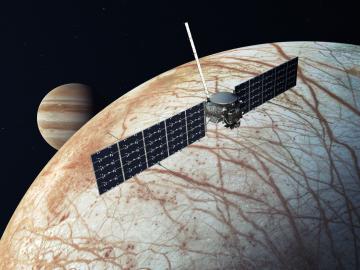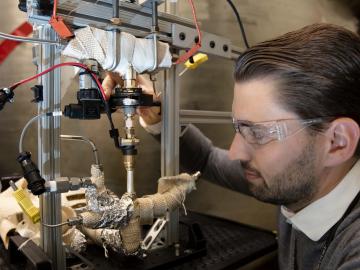
Filter News
Area of Research
- (-) National Security (13)
- (-) Neutron Science (34)
- (-) Supercomputing (76)
- Advanced Manufacturing (6)
- Biology and Environment (38)
- Computational Engineering (2)
- Computer Science (5)
- Electricity and Smart Grid (1)
- Energy Science (106)
- Functional Materials for Energy (1)
- Fusion and Fission (12)
- Fusion Energy (9)
- Isotope Development and Production (1)
- Isotopes (4)
- Materials (91)
- Materials Characterization (1)
- Materials for Computing (18)
- Materials Under Extremes (1)
- Mathematics (1)
- Nuclear Science and Technology (17)
- Nuclear Systems Modeling, Simulation and Validation (1)
- Transportation Systems (2)
News Topics
- (-) Advanced Reactors (3)
- (-) Big Data (26)
- (-) Biotechnology (3)
- (-) Exascale Computing (26)
- (-) Frontier (33)
- (-) Materials Science (33)
- (-) Mathematics (2)
- (-) Space Exploration (5)
- (-) Transportation (12)
- 3-D Printing/Advanced Manufacturing (12)
- Artificial Intelligence (49)
- Bioenergy (16)
- Biology (18)
- Biomedical (28)
- Buildings (4)
- Chemical Sciences (7)
- Clean Water (2)
- Composites (1)
- Computer Science (108)
- Coronavirus (21)
- Critical Materials (3)
- Cybersecurity (23)
- Energy Storage (15)
- Environment (33)
- Fossil Energy (1)
- Fusion (3)
- Grid (11)
- High-Performance Computing (46)
- Hydropower (1)
- Isotopes (2)
- Machine Learning (26)
- Materials (29)
- Microscopy (8)
- Molten Salt (1)
- Nanotechnology (19)
- National Security (36)
- Neutron Science (122)
- Nuclear Energy (10)
- Partnerships (5)
- Physics (18)
- Polymers (3)
- Quantum Computing (20)
- Quantum Science (31)
- Security (15)
- Simulation (16)
- Software (1)
- Summit (43)
Media Contacts

Scientists at ORNL and the University of Tennessee, Knoxville, have found a way to simultaneously increase the strength and ductility of an alloy by introducing tiny precipitates into its matrix and tuning their size and spacing.

Researchers from NASA’s Jet Propulsion Laboratory and Oak Ridge National Laboratory successfully created amorphous ice, similar to ice in interstellar space and on icy worlds in our solar system. They documented that its disordered atomic behavior is unlike any ice on Earth.

The Department of Energy’s Office of Science has selected five Oak Ridge National Laboratory scientists for Early Career Research Program awards.

At the Department of Energy’s Oak Ridge National Laboratory, scientists use artificial intelligence, or AI, to accelerate the discovery and development of materials for energy and information technologies.

The U.S. Department of Energy’s Innovative and Novel Computational Impact on Theory and Experiment, or INCITE, program is seeking proposals for high-impact, computationally intensive research campaigns in a broad array of science, engineering and computer science domains.

For a researcher who started out in mechanical engineering with a focus on engine combustion, Martin Wissink has learned a lot about neutrons on the job

A multi-institutional team became the first to generate accurate results from materials science simulations on a quantum computer that can be verified with neutron scattering experiments and other practical techniques.

In the quest for advanced vehicles with higher energy efficiency and ultra-low emissions, ORNL researchers are accelerating a research engine that gives scientists and engineers an unprecedented view inside the atomic-level workings of combustion engines in real time.

Six scientists at the Department of Energy’s Oak Ridge National Laboratory were named Battelle Distinguished Inventors, in recognition of obtaining 14 or more patents during their careers at the lab.

Six ORNL scientists have been elected as fellows to the American Association for the Advancement of Science, or AAAS.


